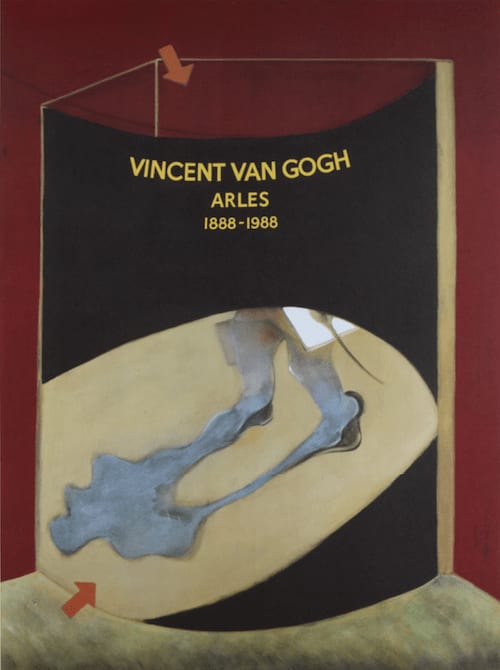
Francis Bacon
94 x 70.5 cm
Francis Bacon’s Hommage a Van Gogh confronts the viewer with a raw, visceral depiction of the artist at his most existentially vulnerable. Far from a traditional homage, Bacon’s rendering strips away the romanticised image of Van Gogh the tortured genius and replaces it with a disfigured, emotionally fraught figure—part historical subject, part psychological projection. The result is a haunting and deeply personal meditation not only on Van Gogh’s suffering but on the fragility of the human condition itself.
In Bacon’s interpretation, Van Gogh appears with a grotesquely distorted face, a pipe clenched in his mouth, and a heavy overcoat draped over his shoulders. His cocked hat sits awkwardly atop his head, while a stark white bandage wraps around his head and neck, covering the infamous wound he inflicted upon himself after a psychological crisis in Arles in December 1888. The incident, one of the most dramatic in modern art history, followed a heated confrontation with Paul Gauguin—after which Van Gogh, in a fugue of mental anguish, sliced off part of his left ear, wrapped it in newspaper, and gave it to a prostitute at a nearby brothel.
Bacon does not seek to recreate this moment literally, but instead captures its lingering trauma. The figure he paints is not simply Van Gogh as a historical personage, but Van Gogh as a symbol of inner torment, emotional rupture, and existential isolation. The composition’s palette is dominated by complementary reds and greens, which heighten the emotional tension through chromatic contrast. Flashes of white and subtle traces of blue in the fur hat provide minor tonal relief, yet the overall atmosphere remains stark and unsettling.
The treatment of Van Gogh’s face is especially striking. Bacon’s brushwork is thick, textured, almost sculptural—transforming the visage into a grotesque mass that resembles butchered meat. It quivers with motion, as if the image were caught mid-transformation, like a blurred photograph or a distorted memory. The Cubist-like deconstruction of facial features destabilizes the figure’s identity. What remains is not a likeness, but an impression—an embodiment of disfigurement and psychic dislocation. The effect is simultaneously horrific and absurd, like a nightmare balanced on the edge of comedy.
The portrait is framed in an unusual way: the figure is pushed toward the lower right corner of the canvas, and the background is divided into an upper, shadowy half and a lower, lighter section. This dual-toned background creates a visual divide between consciousness and oblivion, further isolating the figure within a picture-within-a-picture. The skewed placement and reflective quality of the composition evoke the atmosphere of a self-portrait viewed in a mirror—intimate, yet disorienting. This spatial framing allows the viewer to feel as though they are intruding on a deeply personal moment of reckoning.
Bacon’s series of Van Gogh portraits, developed in the late 1950s and early 1960s, were heavily influenced by two key sources: Van Gogh’s lost painting *The Painter on the Road to Tarascon* (1888), which showed the artist walking with his painting gear, and *Self-Portrait with Bandaged Ear* (1889), painted shortly after the mutilation incident. In these tributes, Bacon reinterprets the motif not with reverence, but with confrontation—emphasising Van Gogh’s psychic torment and casting him as a kindred spirit in suffering and artistic extremity.
The connection Bacon felt with Van Gogh was more than aesthetic. Both artists shared a sense of alienation from the mainstream, an obsessive devotion to their practice, and a refusal to compromise their vision, no matter the personal cost. For Bacon, Van Gogh was not only a historical figure but a mirror—a reflection of his own inner chaos. In this way, the portrait becomes as much a self-portrait as it is a depiction of Van Gogh. The disfigured face, the solitary figure adrift in an abstracted space, the psychological torment veiled in painterly bravado—all echo the themes that define Bacon’s oeuvre.
And yet, the portrait transcends biographical homage. Van Gogh here becomes a symbol of humankind’s existential vulnerability—wounded, misunderstood, and alone. His bandage is not merely a record of physical injury, but a marker of the psychic scars borne by anyone who has lived through despair. Bacon’s interpretation strips away heroism and replaces it with brutal honesty. This is not Van Gogh as martyr or legend, but as a human being confronted by the absurdity of existence.
In the end, Bacon’s *Portrait of Van Gogh* is not a static image but a dynamic psychological study—of Van Gogh, of Bacon himself, and of humanity writ large. It confronts the viewer with a visual language that is at once grotesque and poignant, inviting us to see not just the pain of one man, but the silent wounds carried by many. Through violent brushwork, compositional unease, and emotional depth, Bacon transforms myth into metaphor and offers one of the most searing tributes to the emotional extremes of creative life in modern art.
For more information on Francis Bacon’s Hommage a Van Gogh or to buy Francis Bacon’s Hommage a Van Gogh contact our galleries using the form below.